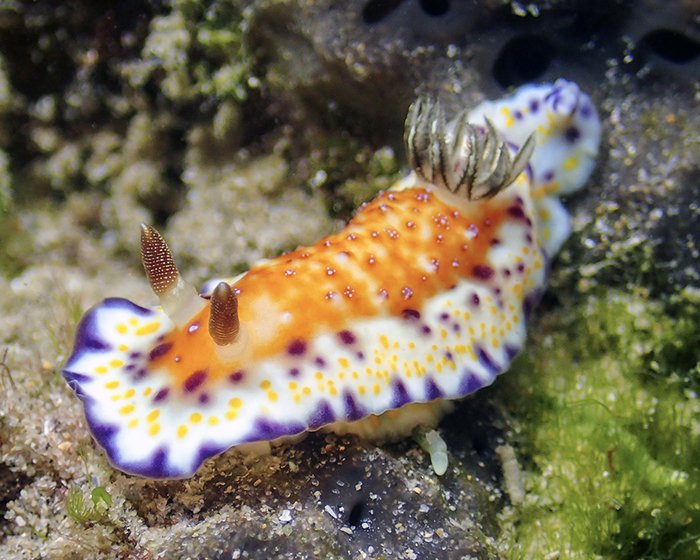Nudibranchs: indicators of climate change

AFTER MONTHS of competing to find as many species of nudibranch as possible, in 2013 Stephen Smith and Tom Davis decided to take a seemingly casual pastime to a whole new level, launching the Nelson Bay Sea Slug Census: a 24-hour competition where particpants capture the kaleidoscopic colours of various different nudibranch species.
But after running for several years now the competition has become much more than a chance to capture these colourfully-armoured slugs. Stephen told Australian Geographic that after consolidating a comprehensive record of different species of nudibranchs in Port Stephens, these slugs, which have a maximum lifespan of just one year, are sensitive indicators of climate change.
“One of the important things about nudibranchs is that they’ve got a very rapid turnover, which means they respond very quickly to changes in the quality of the environment including pollution and loss of habitat,” Stephen said.
“Nudibranchs have specific eating habits, and so they are sensitive to any disruption to their food source. This means we have a fantastic group of organisms, which are likely to respond very quickly to environmental change. And we have all these wonderful divers who want to look for them and photograph them. When you combine this there’s huge potential to monitor the human impacts on marine environments.”

Goniobranchus collingwoodi. (Image Credit: Stephen Smith)
The bright patterns of the nudibranch also play an important role for indicating these changes to scientists. “The good thing about nudibranchs is that they’re so visible. One of the problems when you’re looking for indicators of climate change is that, if you haven’t got much information about a species distribution in the first place, how do you know you’ve found something that’s never been seen at that location before? With the conspicuous nudibranchs, they’re not hidden. If they’re around we would have seen them and would have documented them,” Stephen explained.
Earlier this year the group of nudibranch fanatics identified 12 species that had extended their range to Port Stephens from tropical waters. “We’re starting to get a feel for what is a natural seasonal variation… and we’re looking for signals of change,” Stephen explained.

Goniobranchus geometricus. (Image Credit: Stephen Smith)
Taking the sea slug census beyond Australia’s East Coast
In 2015, the nudibranch census was brought to Sydney by popular demand and it’ll be back in 2017. The Gold Coast has been quick to follow. “The Gold Coast is one of our biggest events because there’s a passionate group of organisers there that have found sponsorship from a range of local businesses. But we’ve also got expressions of interest from Melbourne, South Australia and Western Australia.
Having just returned from three and a half week trip to Indonesia, Stephen is also eyeing the prospect of the sea slug census going global.
“We’re anticipating a sea slug census in Indonesia next year. We’re getting interest from all over the place… it’s been an organic process. We haven’t pushed it but people have been asking to get involved.”

Goniobranchus roboi. (Image Credit: Stephen Smith)
READ MORE:

